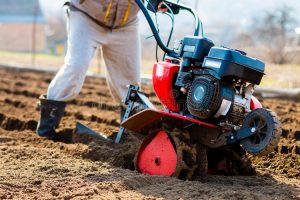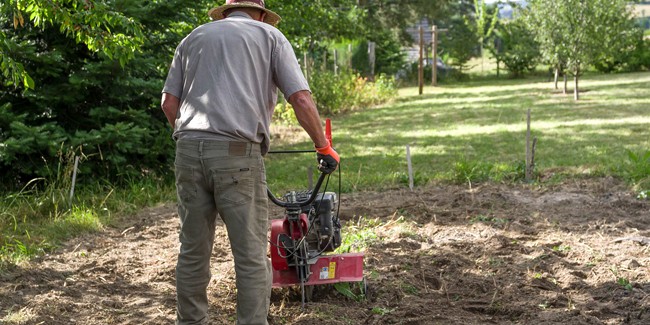New options in tiller design open up new horizons for the DIY gardener. Successful gardening depends on healthy soil. One of the best ways to maintain productive gardens and flowerbeds is to keep the soil well tilled. Tilling provides loose, crumbly soil that will drain well and increase richness by breaking down materials and allowing for better root growth.
On small beds and gardens, the soil can, of course, be broken up with a shovel. A hand cultivator or hoe can then be used to keep the soil loosened and to kill and eliminate weeds around the plants. Motorized machines with rotating tines make the task much easier and are generally considered a necessity for large gardens. These machines are called tillers, cultivators or tillers/cultivators.
The tillers have larger, heavy-duty tines that can be used for first time digging and can often dig the soil to depths of 8 inches or more. These machines can also be used for cultivation. Cultivators are, for the most part, smaller machines with lighter, less robust tines. Cultivators do not work the soil as deeply or as aggressively as tillers. Normally, the digging depth of a cultivator is about 10 cm.
Contents
Tiller Size
Tillers and/or cultivators are available in a wide variety of sizes, ranging from huge commercial machines with 14 horsepower or more and a working width of 90 cm to tiny mini-tillers/cultivators such as the Einhell Electric Weeder. Prices range from several thousand euros for the largest machines to just over a hundred euros for some of the smaller ones. The larger units require more storage space and some are more difficult to operate. Smaller machines have become increasingly popular because they are easy to operate and lighter.
Tiller Drive
Most tillers are powered by two-stroke engines. However, a number of manufacturers are now producing tillers / cultivators powered by four-stroke engines. Although they are more expensive, they offer several advantages, including lower emissions, a very important factor in today’s increasingly green world. The second factor is simply ease of use. Oil and gasoline do not have to be premixed with four-stroke engines. They also tend to have fewer maintenance problems and last longer. Most of the higher horsepower models are available with electric start. Tillers are available in front-tine, mid-tine and rear-tine models.

Front tine tiller
The rotating tines of front tine tillers pull the tiller. With this design, muscle power must be used to tilt the tines into the ground to operate the machine. Muscle power is also needed to hold the machine to control the tilling depth and/or push to propel the machine forward. All of this is physically tiring and makes it difficult for some people to operate the larger front tine tillers. The engine sits slightly behind or almost on top of the tines of front tine tillers to provide weight. This design, however, is a bit more difficult to use on larger units, especially when breaking in hard, uneven or rocky ground. When the tines grip hard obstacles, they tend to jump or move the machine forward. Although front tine tillers are shorter than rear tine models, they can be more maneuverable in smaller spaces. Front tine models are available in large, medium and mini sizes. The larger models will fit even the largest gardens.
The medium size front tine tiller models have become very popular with suburban landowners. With horsepower ranging from 3.5 to 4, these medium-sized machines can easily handle gardens up to 250 square meters. Most larger and medium-sized machines have more than one forward gear, in addition to reverse. This makes it easier to control the unit in hard soil by using a lower gear, then shifting to a higher gear in softer soil. Reverse gear allows you to get out of turns or away from obstacles.
Mini tiller / cultivators
The mini-models are perfect for small garden areas up to about 50 square meters. They can even be used for raised bed gardening or landscaping. Some of these models weigh less than 10 kg and can be easily transported to the job site or lifted into raised beds. All mini-mowers are front tine. Working widths range from 20 to 40 cm and some of the better units have adjustable working widths. Some mini tillers have a variety of attachments that can be interchanged with the tilling tines. This means you can buy and stock only one engine, then simply swap out the accessory tools as needed. Typical attachments include edgers, dethatchers and aerators. Some models also have plows, furrows and cutter bars. Many of these units have transport wheels so you can easily roll them from place to place.
Mid-Tine Tillers
Mid-tine tillers have the engine directly above the tines, providing more weight and balance to the machine than front tine tillers. The cost of mid-tine units is generally higher than the same size and horsepower model with front tines. Because mid-tine units are always powered by the tines, they are generally classified as front-tine tillers. Mid-tine tillers are actually the most maneuverable of the models and are available as large and medium-sized machines. Front and mid-tine units are generally more economical than comparable rear-tine models.
Rear Tine Tillers
The tines of rear tine machines are driven independently of the forward or reverse movement of the machine. The motor sits well in front of the gearbox, with the teeth at the rear. These machines certainly require much more storage space. Because they are more complicated and usually have higher horsepower, they are naturally more expensive than other models. Horsepower ranges from 5 to 14, with 6 to 8 horsepower considered adequate for most owner tasks. Although not as maneuverable as some of the smaller models, these machines are the easiest to operate because the wheels drive the machine, with the tines working independently. This is a real asset in hard soils or when opening up new ground, as the units don’t jump or shake when they hit an object. These machines also make it easier to work at consistent depths. The drive wheels can only propel the machine forward at a set speed, regardless of the forward action of the rear tines. This means that the drive wheels can actually hold the machine in place so that the tines can dig the seedbed to the desired depth. The forward movement can even be stopped and the tines will still dig. Compost can be worked with these units, as the forward movement of the fast rotating tines cuts the material and mixes it with the soil.
With these large units, you can easily cultivate and maintain a garden of 700 square meters or more. The working width varies from 40 to 60 cm. A large metal cover on the back of the tiller covers the tines, protecting your feet and preventing debris from being thrown up by the turning action.
Rear tine models often have both front and rear tines, with multiple front speeds. Some units have multiple tilling speeds, and some models also have counter-rotating tines. The tines can be set in forward motion for cultivation or when grinding soft soils, or in reverse motion for grinding hard soils. However, counter-rotating tines do not produce the consistent results of forward rotating tines.
Because of the method of propulsion, rear-tine tillers are fairly easy to steer. You can start, stop, speed up and slow down, all independent of the tilling action. Some models have a pivoting handlebar that allows you to plow without the operator stepping on it and compacting the freshly tilled soil. You can walk down a row while plowing the row next to you. Many manufacturers of rear tine machines also offer attachments such as snow blades, snow blowers and cutter bar mowers.
Tillers are a fairly expensive investment for a tool used seasonally. It’s important to determine your needs – the types of gardening, landscaping or flower growing you plan to use the tiller for – before you buy.


